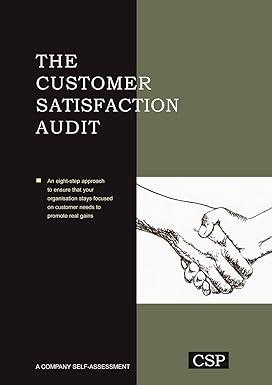Question
As weve previously seen, equations describing situations often contain uncertain parameters, that is, parameters that arent necessarily a single value but instead are associated with
As weve previously seen, equations describing situations often contain uncertain parameters, that is, parameters that arent necessarily a single value but instead are associated with a probability distribution function. When more than one of the variables is unknown, the outcome is difficult to visualize. A common way to overcome this difficulty is to simulate the scenario many times and count the number of times different ranges of outcomes occur. One such popular simulation is called a Monte Carlo Simulation. In this problem-solving exercise you will develop a program that will perform a Monte Carlo simulation on a simple profit function. Consider the following total profit function: PT = nPv Where PT is the total profit, n is the number of vehicles sold and Pv is the profit per vehicle in a simple calculation made when figuring the profit made from selling a car.. PART A Compute 5 iterations of a Monte Carlo simulation given the following information: n follows a uniform distribution with minimum of 1 and maximum 10 Pv follows a normal distribution with a mean of $5500 and a standard deviation of $1000 Number of bins: 10 Recall that for all practical purposes we will use 3 std. deviations from the mean as the maximum value for parameters following a normal distribution. Obviously, 5 iterations are not very many. In fact, typically you would simulate 10,000 iterations or so to view meaningful results but I figured that Id give you a break . If youd like to compute 10,000 iterations by hand for extra credit, go ahead i.) What are the ranges for the 10 bins? ii.) Fill in the table below: Parameter Iteration 1 Iteration 2 Iteration 3 Iteration 4 Iteration 5 n 3 7 8 4 5 Pv $3200 $4500 $5500 $7500 $2500 PT Bin # $ Range iii.) Fill in the frequency of occurrences of each bin: 1: 2: 3: 4: 5: 6: 7: 8: 9: 10: PART B Write the following three functions in a module called Simulate: Public Function GetRandomUniform(ByVal min As Integer, ByVal max as Integer) as Integer This function returns a random number from a uniform distribution between min and max. Public Function GetRandomNormal(ByVal mean As Single, ByVal stddev as Single) as Single This function returns a random number from a normal distribution with a mean of mean and standard deviation of stddev Public Function GetBinIndex(ByVal mini As Single, ByVal maxi As Single, ByVal numbins as _ Integer, ByVal valuetobin as Single) As Integer This function returns the Bin Index given an output minimum of mini, output maximum of maxi, numbins number of bins, and a value to bin of valuetobin PART C Include the module created in part B to develop a Visual Basic .NET program that will simulate the basic profit calculation, PT = nPv, where n follows a uniform distribution, Pv follows a normal distribution, and the user can input the number of bins and number of iterations. The user must also input the min and max for n and the mean and standard deviation for Pv. Finally, the user can click a button and the results will be graphed on a bar chart using the Microsoft Chart Control and the average total profit (PT) will be displayed in a textbox. Turn in a screen shot of the resulting chart using: 1. Iterations: 10000 Bins: 5 n-min: 1 n-max: 10 Pv-mean: 7000 Pv-stddev: 1000 2. Iterations: 10000 Bins: 10 n-min: 1 n-max: 10 Pv-mean: 7000 Pv-stddev: 1000 3. Iterations: 10000 Bins: 10 n-min: 1 n-max: 10 Pv-mean: 6000 Pv-stddev: 500 Thats three screen shots. PART D Extend the Visual Basic .NET program developed in part C to simulate the basic profit calculation, PT = nPv, where the user can select either a uniform or normal distribution for n using radio buttons and then must input the appropriate parameters (min and max if they select uniform, mean and standard deviation if they select normal) and they can similarly select either a uniform or normal distribution for Pv with appropriate parameters depending on the selection. Of course, the user will input the number of bins and number of iterations. Finally, the user can click a button and the results will be graphed on a bar chart using the Microsoft Chart Control and the average total profit (PT) will be displayed in a textbox. Also include in the program any necessary input validation for all input values. Turn in a listing of the code and a screen shot of the resulting chart using: 1. Iterations: 10000 Bins: 5 n-min: 1 n-max: 10 Pv-mean: 9000 Pv-stddev: 1500 2. Iterations: 10000 Bins: 10 n-mean: 7 n-stddev: 2 Pv-min: 2000 Pv-max: 10000 3. Iterations: 10000 Bins: 10 n- mean: 12 n- stddev: 3 Pv-min: 1000 Pv-max: 10000 Thats three screen shots and a code listing. PART E Youre going to go to a job interview for OU Car Co. Knowing that the field is highly competitive, you have run sales scenarios ahead of time experimenting with different numbers of customers and vehicle profits given that in one month OU Car Co. sells between 3 and 10 cars uniformly distributed with profits of $5,000 on the average with standard deviation of $1500. Which has a higher payoff, focusing on selling to a couple more customers or by increasing the average sale (with the same std. dev. of $1500) by retraining your sales force or do they have basically the same effect on total sales? Support your answer.
please solve all these questions.
Step by Step Solution
There are 3 Steps involved in it
Step: 1

Get Instant Access to Expert-Tailored Solutions
See step-by-step solutions with expert insights and AI powered tools for academic success
Step: 2

Step: 3

Ace Your Homework with AI
Get the answers you need in no time with our AI-driven, step-by-step assistance
Get Started


